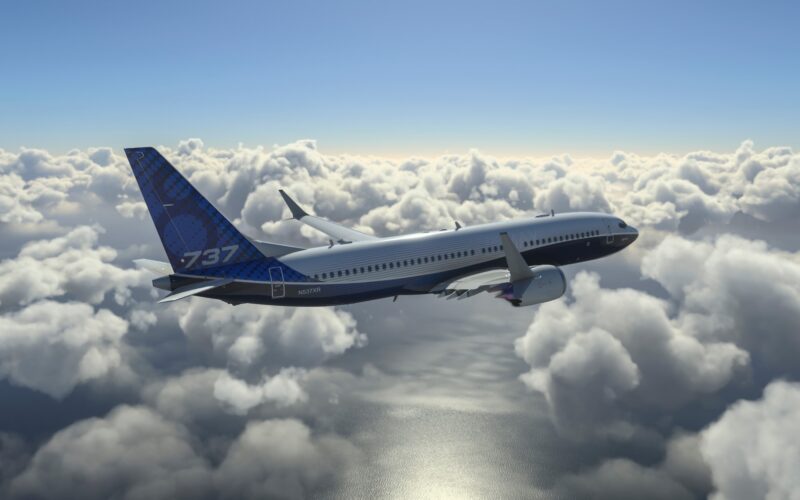In a letter to the Federal Aviation Administration (FAA) the chair of the National Transport Safety Board (NTSB) Jennifer Homendy has suggested that at least 40 non-US operators could be flying Boeing 737s with a defective actuator installed.
On September 26, 2024, the NTSB issued an urgent safety recommendation to Boeing and the FAA following an incident at Newark Liberty International Airport (EWR) in February 2024, when the rudder pedals jammed on a United Airlines 737 MAX 8.
The aircraft potentially affected include certain Boeing 737NGs and 737 MAXs equipped with a Collins Aerospace SVO-730 rudder rollout guidance actuator that tests found to be defected.
In Homendy’s letter addressed to the FAA head on September 30, 2024, she said that 353 affected actuator units were delivered to Boeing starting from February 2017.
“Of these 353 units, we understand that 73 have not yet been installed on airplanes. Another 271 affected actuators that may be installed on aircraft in service operated by at least 40 foreign air carriers; 16 may still be installed on US-registered aircraft,” Homendy wrote.
On August 28, 2024, Boeing notified the NTSB that 25 US-registered planes have or had an affected SVO-730 rudder rollout guidance actuator installed.
Boeing advised that nine of the 25 aircraft were operated by United Airlines and that all the actuators installed on those planes had already been removed, while the other 16 were leased to foreign operators.
Homendy said in her letter to the FAA that the actuator manufacturer Collins additionally sent 75 affected parts “directly to operators for aftermarket installation”.
“Some of these may be spares, while others may currently be on airplanes in service. Accordingly, it is essential that aftermarket installations of affected actuators also be clearly addressed,” the NTSB chair wrote.
Boeing has indicated that 737 airplanes can be safely flown without the rudder rollout guidance actuator installed and that it issued information about the part in a Multi Operator Message to both domestic and foreign operators on August 23, 2024.
The NTSB accepts that the removal of Collins Aerospace SVO-730 rudder rollout guidance actuators with incorrectly assembled bearings from Boeing 737 planes would eliminate a potential cause of a restricted rudder control system on those planes.
However, in its recent safety recommendation the NTSB said that it is concerned that Boeing’s “mitigation to overcome a jammed or restricted rudder control system during landing could also result in a large input to the rudder pedals and a sudden, large and undesired rudder deflection sufficient to cause loss of control or departure from the runway”.
NTSB chair critical of FAA response
In her letter Homendy also said that she was “concerned” that the FAA did not take the actuator issue “more seriously” until the NTSB issued its urgent safety recommendation last week despite the possible risk to some aircraft.
“I am disappointed that it does not appear that the FAA has initiated urgent actions to address the risk of jammed rudder controls in the 6 months since our preliminary report on this incident was issued,” Homendy wrote.
According to the NTSB, this was despite the FAA knowing that two similar incidents to the United Airlines 737 MAX 8 rudder situation in February 2024 occurred with foreign operators in 2019.
“Moreover, in briefing the media and congressional committees of jurisdiction, I was made aware that the FAA has been downplaying the urgency of this issue, maintaining that the units are no longer in service. According to information that we have received from Boeing and provided to the FAA, this is incorrect,” Homendy added.
The FAA said in a statement that the issue is being addressed and is sending information to foreign airlines.
“We thank the NTSB for the recommendations, and we are taking them seriously,” the FAA said.
Boeing also criticized
“Equally concerning is Boeing’s failure to inform United Airlines that the 737 airplanes it had delivered to the airline were equipped with these actuators—and that the actuators were mechanically connected to the rudder control system,” Homendy wrote in her letter.
Homendy is concerned that other operators may not be aware of the presence of these actuators on their 737 planes and may not know what to expect if the rollout guidance actuator fails at low altitude or during landing and rollout.
“Not making operators fully aware of the installed systems and equipment on the airplanes delivered to them is unacceptable and cannot continue to be tolerated,” Homendy concluded in her letter.
What happened to United Airlines 737 MAX 8 in February 2024?
The captain of the United Airlines flight involved in the incident reported that, during the landing rollout, the rudder pedals failed to move in response to the “normal” application.
In subsequent tests at the Collins Aerospace facility in Cedar Rapids, it was found that during “cold soaking” the actuators’ function was “significantly compromised”.
“Investigators found evidence of moisture in both actuators, which failed testing. Collins Aerospace subsequently determined that a sealed bearing was incorrectly assembled during production of the actuators, leaving the unsealed side more susceptible to moisture that can freeze and limit rudder system movement,” the NTSB said in its urgent safety recommendation on September 26, 2024.

